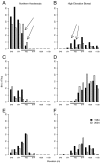A rapid upward shift of a forest ecotone during 40 years of warming in the Green Mountains of Vermont
- PMID: 18334647
- PMCID: PMC2393766
- DOI: 10.1073/pnas.0708921105
A rapid upward shift of a forest ecotone during 40 years of warming in the Green Mountains of Vermont
Abstract
Detecting latitudinal range shifts of forest trees in response to recent climate change is difficult because of slow demographic rates and limited dispersal but may be facilitated by spatially compressed climatic zones along elevation gradients in montane environments. We resurveyed forest plots established in 1964 along elevation transects in the Green Mountains (Vermont) to examine whether a shift had occurred in the location of the northern hardwood-boreal forest ecotone (NBE) from 1964 to 2004. We found a 19% increase in dominance of northern hardwoods from 70% in 1964 to 89% in 2004 in the lower half of the NBE. This shift was driven by a decrease (up to 76%) in boreal and increase (up to 16%) in northern hardwood basal area within the lower portions of the ecotone. We used aerial photographs and satellite imagery to estimate a 91- to 119-m upslope shift in the upper limits of the NBE from 1962 to 2005. The upward shift is consistent with regional climatic change during the same period; interpolating climate data to the NBE showed a 1.1 degrees C increase in annual temperature, which would predict a 208-m upslope movement of the ecotone, along with a 34% increase in precipitation. The rapid upward movement of the NBE indicates little inertia to climatically induced range shifts in montane forests; the upslope shift may have been accelerated by high turnover in canopy trees that provided opportunities for ingrowth of lower elevation species. Our results indicate that high-elevation forests may be jeopardized by climate change sooner than anticipated.
Conflict of interest statement
The authors declare no conflict of interest.
Figures





References
-
- Mann ME, Bradley RS, Hughes MK. Nature. 1998;392:779–787.
-
- Easterling DR, Evans JL, Groisman PY, Karl TR, Kunkel KE, Ambenje P. Bull Am Meteorol Soc. 2000;81:417–425.
-
- Stott PA, Tett SFB, Jones GS, Allen MR, Mitchell JFB, Jenkins GJ. Science. 2000;290:2133–2137. - PubMed
-
- Karl TR, Trenberth KE. Science. 2003;302:1719–1723. - PubMed
-
- Hansen J, Nazarenko L, Ruedy R, Sato M, Willis J, Del Genio A, Koch D, Lacis A, Lo K, Menon S, et al. Science. 2005;308:1431–1435. - PubMed
Publication types
MeSH terms
LinkOut - more resources
Full Text Sources

